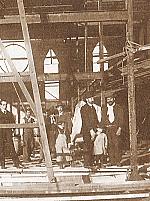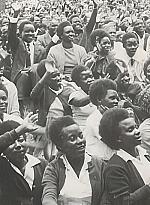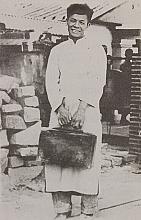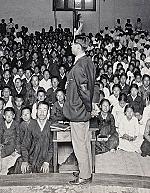God in the villa miseria
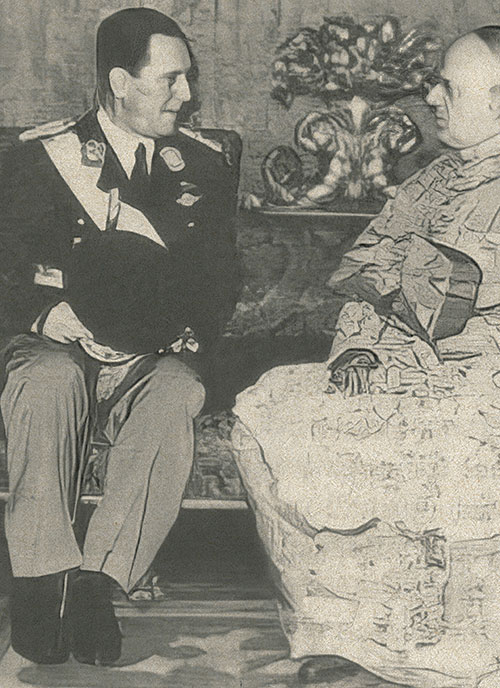
[Above: President Juan Domingo Perón and the Archbishop of Buenos Aires Santiago Luis Copello, October 1949. Mundo Peronista—Public domain, Wikimedia]
The Vélez Sarsfield soccer stadium in Buenos Aires, Argentina, has a long and storied history. Home of a beloved football team, the stadium hosted the FIFA World Cup in 1978. Rock bands have often packed the place with screaming fans. But in 1996, the stadium hosted a more important event. An unknown 28-year-old evangelist, Dante Gebel (b. 1968), filled the stadium with over 50,000 young people. By night’s end thousands were on their knees, confessing sin and crying out for a fresh start with God. And this was not an isolated event. For nearly 20 years, from the early 1980s to the late 1990s, mass conversions, dramatic expressions of deliverance, and fresh forms of worship and unity swept over the nation in a movement known as the Argentine Revival.
A troubled past
The roots of this movement lay deep in Argentina’s past. After World War II, Argentines saw their nation embark on one of the most volatile political journeys of the century. Juan Peron (1895–1974) accounted for much of the turbulence. A popular ex-military officer, Peron became president in 1946, only to be ousted by the military in 1955. He was reelected in 1973 but died the next year, triggering another military takeover. From 1976 to 1983, military generals ruled Argentina. Seeking to eradicate left-leaning elements from the country, the junta was responsible for the disappearance of 30,000 citizens, victims of the ruthless “Dirty War” against social and political opposition. The culture of fear created by the military paralyzed the economy. Inflation spiraled out of control (by one estimate, between 1976 and 1991, prices increased 20 billion times).
The 1982 Falklands (or Malvinas) War, a territorial dispute with Great Britain, ended in a humiliating defeat, leading to the end of the military government. For many Argentines this was the last straw. The state had failed. The search for alternative sources of hope and security intensified.
The Unlikely Evangelicals
Surprisingly, many Argentines turned to the Evangélicos in this time of personal and political crisis. Evangelicalism, made up of all Protestants including Pentecostals, was originally seen as a foreign faith led by North American missionaries. Missionary Christianity in the nation was characterized by disunity and foreign control, and thus evangelical churches seemed ill-suited to the role of liberation.
Coming to Argentina in the 1940s, many denominational churches had been reluctant to empower local converts. Those who brought the gospel also brought a long list of doctrinal distinctions and moral rules. Even Pentecostal missionaries expressed skepticism about healing and deliverance ministries. “Denominationalism” was a barrier to the unity and witness of the broadly evangelical movement, as illustrated by the reaction to the Hicks crusade of 1954.
The practice of charlatans?
A group of Assemblies of God churches sponsored American healing evangelist Tommy Hicks (1908–1973) for a three-month crusade in Buenos Aires. Thousands came for salvation and healing. The final event, held in one of Argentina’s largest stadiums, turned away over 300,000 because of a lack of seating. Even with this public response, most mission churches were critical of the crusade, regarding “faith healing” as the practice of charlatans.
As Argentine pastor/scholar Pablo Deiros sums up the situation during those decades,
This generation of missionaries arrived in force beginning in the 1940s and generally did not relinquish church control to local leaders until the 1960s. . . . Missionary founders brought with them social, cultural, and political prejudices, and, crucially, denominational antagonisms peculiar to marginalized conservative Protestants in the mid-twentieth-century United States.
With that baggage it’s no surprise that evangelicals numbered only about 2 percent of the nation’s population in 1980, an almost invisible group compared to the Catholic Church.
Yet despite conservative resistance, new leaders emerged who challenged the prevailing missionary paradigm. Carlos Annacondia (b. 1944) was the unlikely forerunner of a new revival of Christianity that would sweep over Argentina in the next two decades. In 1979 Annacondia, a 39-year-old entrepreneur, underwent a personal conversion and immediately felt called to share his faith with a larger audience. His call came through a series of visions. He saw himself standing before thousands in the impoverished areas of Buenos Aires (villa miseria). In 1981 the vision came true. Annacondia held his first crusade in Bernal, a poor community in Greater Buenos Aires. He described his experience of the call:
God showed me that villa miseria for an entire year, but I didn’t want to go. Finally, I said, “I give up,” and I went. I went into mud up to my knees but I didn’t feel a thing. . . . I felt love for those people that had so many problems. God protected me; He gave me authority over that place—I cast the demons out of those people and out of that place and then one day God took me out of there and put me in a residential neighborhood. And I used the same message to convert the rich as I had used to convert the poor.
By 1983 Annacondia claimed some 6,000 conversions. Refusing to align with any denomination, he extended invitations to all churches. This strategic policy gradually eroded the rigid lines of denominationalism and brought a new sense of unity to the evangelical movement in Argentina. The La Plata crusade of 1984 was a turning point. About 10 percent of all the Protestants in the city took part. Over the eight months of the campaign, some 50,000 people made decisions for Christ.
Annacondia’s message and methods became the template for a host of revivalists who would follow his lead. The unity of believers was an underlying principle that grounded all of his ministry. His meetings began with new and more expressive music than most nominal Christians had heard in church. The gospel he preached focused on Christ as the victor over the devil. Many attendees gave public testimonies, and then Annacondia would invite seekers to come forward for personal salvation and deliverance from specific diseases and manifestations of the power of evil, including demonic possession. The method for receiving these gifts of grace was the prayer of faith and the laying on of hands. Every aspect of his presentation was a direct challenge to missionary Christianity.
Liberation and reformation
For the average Argentine, evil spirits dominated every aspect of life. Annacondia presented Christ as the solution. Through the blood of Christ, the power of God was unleashed to overcome demons and liberate humanity from the grip of evil. This message was consistent with the popular Catholicism that had shaped much of Argentinian spirituality and worldview, but it added an evangelical emphasis on personal faith—and not the church’s rituals—as the way to receive the power of Christ for salvation and deliverance.
Annacondia inspired a host of younger revivalists who brought a “Christus Victor” message to every part of the nation in the 1990s. Prominent evangelists included Oscar Cabrera (who anticipated some aspects of Annacondia’s evangelism in the 1970s), Héctor Giménez, Claudio Freidzon, Eduardo Lorenzo, Omar Olier, Victor Lorenzo, and Marfa Cabrera. Cindy Jacobs and Marcos Witt added new forms of prayer and worship to the mix.
The ripples of the revival in Argentina have spread far and wide. Megachurches have multiplied throughout the country. The anointing movement (spiritual power and joy through the laying on of hands) spread to North America, most notably to Toronto in the 1990s. Argentine Christians report widespread healings, especially among the poor, reforms in the prisons, and hundreds of thousands professing faith. The culture of fear that gripped Argentina during the “Dirty War” has subsided. Evangelicals now make up 25 percent of the population. A significant milestone occurred in 2023 when the Argentine parliament approved the official recognition of “Reformation Day” annually on October 31, a surprising development in what had once been one of the most Catholic nations in Latin America.
Assessments of the Argentine Revival vary. Persistent questions remain about the quality of this revival. Many excesses have been reported. The scandal of moral failure by certain prominent revival leaders has brought criticism from within and without. Theological issues abound. Proponents, however, emphasize the miracles, conversions, and unity as signs of the Spirit.
In 1741 Jonathan Edwards published his Yale commencement address, Distinguishing Marks of a Work of the Spirit of God, to answer criticisms of the Great Awakening in New England. He noted the excesses of the Awakening, including an over-reliance on visions, bodily expressions (even barking), and the scandalous behavior of leaders. For Edwards these were unreliable signs that neither proved nor disproved a genuine work of the Spirit. The reliable signs of a genuine work of the Spirit of God consisted largely of a focus on Jesus as Savior, opposition to Satan’s kingdom, a greater regard for the Scriptures, and a spirit of love for God and man. The revival in Argentina would seem to fall somewhere within Edwards’s parameters. Ultimately for Edwards and for observers today, the final judgment in these matters belongs to God and God alone. CH
By Mark Shaw
[Christian History originally published this article in Christian History Issue #153 in 2024]
Mark Shaw is the director of the Centre for World Christianity at Africa International University and author of several books, including Global Awakening.Next articles
“Indescribable sweetness”
Willis Collins Hoover (1858–1936), the founding pastor of the Church of Chile, recorded his stirring account of the 1909 revival in Chile.
Willis Collins HooverSupport us
Christian History Institute (CHI) is a non-profit Pennsylvania corporation founded in 1982. Your donations support the continuation of this ministry
Donate



